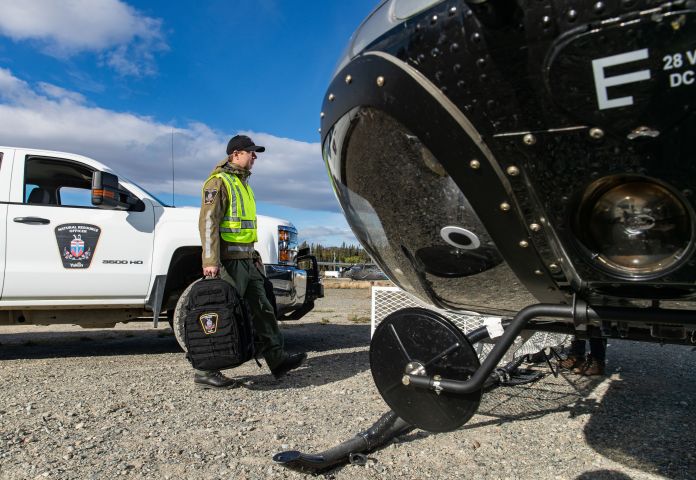What to expect in this role
- a rewarding career that takes you outside into the Yukon’s wilderness;
- travel throughout the territory by ATV, boat, ski-doo and helicopter;
- working in a place voted as one of Canada's Top 100 Employers; and
- job security, and competitive pension and benefits packages.
What we do
A natural resource officer is responsible for the conservation and protection of the environment. They check and inspect activities related to the use or extraction of the Yukon’s natural resources. Natural resource officers in the Yukon are responsible for many industries and functions, including:
- forestry;
- mining;
- oil and gas;
- land use;
- water quality monitoring; and
- flood forecasting.
Other regions in Canada have specific positions for each industry, like forestry officers or lands officers. We have a holistic approach at the Government of Yukon. Natural resource officers work in one of the Yukon’s five districts. Each district has a team led by a senior officer that supports operations in their region.
Pay and benefits
- Annual salary ranging from $89,704 - $104,043;
- pay grid for Yukon Employees Union employees; and
- see this page for benefits and leave information.
Job description
Natural resource officers report to the senior natural resource officer and work independently to provide professional analysis, advice and actions related to natural resource management and play a key role in monitoring and enforcing natural resource legislation.
This position is responsible for:
- ensuring compliance with licenses, authorizations, operational plans, policies, regulations and legislation;
- identifying non-compliance and implementing corrective measures;
- responding to violations and complaints and leading investigations;
- conducting inspections and completing reports; and
- providing excellent client service.
Natural resource officer positions are classified as ST15, with a salary range of $80,913 - $93,848.
Training
Natural resource officers receive regular and annual training in skills such as wilderness first aid, firearms (shotgun) proficiency, ATV/snowmobile use, and sector specific training such as water sampling. Additional training opportunities are available such as helicopter safety, boat training, water safety, interviewing skills, investigation skills, case studies and seminars.
Recruiting process
There is no single, set path to becoming a natural resource officer. Each officer brings a unique background and expertise to work for the benefit of the public, industry and the environment. Discover the journey of 3 natural resource officers to learn all about the:
- unique backgrounds of natural resource officers;
- best parts of their job;
- highlights of their careers so far; and
- pieces of advice they'd give to potential applicants.
Job requirements
- degree or diploma in natural resources management or related field;
- experience interpreting or applying documents such as legislation, policies or procedures; and
- experience working with resource management or environmental stewardship sectors.
“A day in the life”
Every day is a new adventure, different from the last. Here’s what your typical day could look like.
It’s early autumn in the Yukon. The leaves are just starting to change. The sun rises early and warms the days to 20°C. You’re a natural resource officer and your first task is a routine inspection of a forestry operation. Another natural resource officer, less familiar with forestry inspections, joins you.
You drive on the highway, then take your work pickup truck along an established logging road. The forestry operation emerges around a corner. There are no immediate concerns when you arrive. A closer look reveals an oily pool under a piece of equipment. Also, a hydraulic line shows significant wear.
You and your colleague collect soil samples and take water samples from a nearby stream. You complete the inspection by walking around the cut block. You’re looking to ensure the operation is meeting the terms and conditions of the forestry permit. Plus, you want to see compliance with their harvest prescription including:
- timber type;
- spacing between trees;
- tree retention; and
- soil disturbance.
One of the key parts of being a natural resource officer is to build rapport with industry members. That way, you’re as familiar with this producer as they are with you. They’re receptive to the concerns you have after the inspection. Everything else about their operation is in order. You work with your colleague to write the report that includes:
- direction on cleaning up the spill following environmental laws; and
- a date when you expect corrective action to be complete.

